Many authoritative commentaries on Maharshi Patanjali’s Yoga Sutra are available in the
market. But it has been observed
that the available literature is either too complex or too
bulky to generate the interest. Further, most of the literature also
appears to have been
explained with a conditioned mind set. Hence the inspiration to compose the present book.



|
| Download Patanjal Yog chapter | Articles on Meditation, Adhyatam and
Self-Knowledge | Learn basics of Vedic Astrology | Buy and gift Patanjal
Yog book -and help poor-n-needy students for their education |
Introduction All human beings are bestowed with latent psychic capabilities, which can be revealed by various methodologies mentioned by Maharshi Patanjali. By practicing these scientific techniques, human beings can attain their natural state of bliss and thus realize the ultimate Truth. On material front, one can gain positive attitude, enjoy better health, and lead a harmonious & happy life. Why this Book? Many authoritative commentaries on Maharshi Patanjali’s Yoga Sutra are available in the market. But it has been observed that the available literature is either too complex or too bulky to generate the interest. Further, most of the literature also appears to have been explained with a conditioned mind set. Hence the inspiration to compose the present book. Reader’s Segment This book has been specifically designed to cater to the needs of both the beginners and the advanced seekers. Its compactness will be of special interest to busy people for whom time is a major constraint. Uniqueness of the Book
The composer of this book is an IT professional and has more than 22 years of experience in handling software projects in India and abroad. His last assignment was an “Engagement Manager” with American Express, Houston, Texas, USA. He has had keen interest in Adhyatam and was fortunate to have been blessed by Guru and many other learned people. Under their expert guidance, he had deep insight and experiences in Adhyatam. All this has flowered in the shape of this book. Noble Cause The basic motive behind this effort is to spread the teachings of Maharshi Patanjali amongst the true seekers. But at the same time, it was the fervent desire of author to help needy and poor students in their education. Therefore, all the profit earned from the sale of this book will be utilized for this noble cause. Website Support A platform for serious interaction with the readers has been provided on http://www.geocities.com/shanky_andy, where in other articles on Adhytam, Yoga, Meditation, Spirituality etc. are also available. Future Plans The author proposes to bring out the English and Punjabi versions of this book, along with MP3 CD for recitation. How to procure the Book? Book "Patanjal Yog (Ashtang Yog)", ISBN # 81-7525-725-3, can be procured from following outlets -
Avail 25% discount on bulk purcahse i.e. 10 or more books.
Buy and gift this book, and in turn help needy and poor students in completing their education.
ARTICLE - Direct perception of Self (Adhyatam) from Veda’s perspective
All living beings, consciously or unconsciously,
are trying to get rid of pain or suffering. Throughout the life, we keep
running after pleasure, but are unable to attain the true bliss. If we
examine deeply, we will realize that all pleasures are pain underneath -
which means that pain is attached to all phases of the pleasure i.e.
attainment, safeguard, consumption, destruction and violence. That's why
Indian philosophers have meditated on the following four basic
questions –
Q. What should be eradicated? A. Pain, which is due in the future. Q. What is the source of pain? A. Consciousness and matter’s union, which is based upon wrong-knowledge (Avidya), where consciousness gets identified with matter. Q. What is that state, where there is no pain? A. Having no wrong-knowledge. Q. How to achieve the above state? A. Through right-knowledge (Vivek-Khyati) i.e. consciousness is separate from matter.
ARTICLE - Interplay of Consciousness and matter
In order to understand the overall concept, we
will take an analogy. In the dark, when light falls on moving fog, it
creates various shapes and illusions. For illusions to exist, both fog
and light are necessary. Illusions are nothing but interplay (emulsion
or fusion) of reflection-of-source-of-light and moving fog. In the above analogy, source of light is the Pure Consciousness, where as fog represents ever changing and inert matter, which is made of ever changing qualities (Gunas) i.e. light (Satava), action (Rajas) and inertia (Tammas). The overall reflection-of-source-of-light on the matter is known as Atama, which is one because there is one to one relation between the source of light and reflection-of-source-of-light. Both Pure Consciousness and matter are eternal i.e. without beginning and no end. Since Pure Consciousness and matter are eternal, Pure Consciousness’s reflection is also eternal. Also, matter is dependent upon Pure Consciousness. Pure Satava portion of this emulsion is known as Ishwar (Puresh Vishesh, Sagun Bhram, Shabal Bhram, Apar-Bhram), which is Collective Mind (Chitta) – the controller and owner. Like a magnet, Ishwar’s proximity makes cyclic changes in the matter i.e. manifestation at gross, subtle and causal level. Following 24 cascading changes takes place in matter –
With the help of Sadhana (right understanding and right actions), Pursha realizes that "Atama is different from matter" (Vivek-Khayati) and gets established in its true-self (Samadhi). When Atama is realized by Pursha, then Pure Consciousness can be understood by inference, because Atama is the reflection of the Pure Consciousness. Then Pursha no longer identifies itself with matter and thus appears to gain freedom, which was never lost. Then individual Chitta gets absorbed (Kaivlya) in to Collective Chitta i.e. Ishwar. This completes the interplay (Leela) between Pursha and Prakriti (matter)!
ARTICLE - Three Bodies
Three bodies are -
ARTICLE - Four states of consciousness
Four states of consciousness are -
ARTICLE - Law of Karma
Events of our life are based upon relationship of
cause and effect. Our past karmas (thought, speech and deeds) give us
current results and thus influence our future karma too. Our karmas act
as a propeller and decide the next course of action for us. Because of
karma, we become conditioned and go through the purification process
created by matter (Prakriti). There are various categories of karma-s, which can be explained via Bowman's analogy –
From quality perspective, karma can also be divided in the following four types -
Accumulated karma in the latent form is called Samskara, which is the subtle base of our manifested desires (Vasanas). Samskara further gets strengthened by wrong-knowledge (Avidya), and because of ignorance one starts considering –
ARTICLE - Five Sheaths
Our internal organs are covered with various layers made of skeleton,
bio-magnetism, muscles and skin etc. Similarly, Separated Consciousness
is covered with five sheaths (Kosha).
ARTICLE - Ego
Whole is pure existence, consciousness and bliss. Whole is complete,
one, beyond, infinite, omnipresent, omniscient, owner and controller. Process of unfolding or emulsion (consciousness and matter) starts when dormant-ego becomes active, which with the help of wrong-knowledge metaphorically demarcates a fraction from the Whole. This gives rise to “I” and “Mine”, which tries to expand in a wrong direction i.e. externally, to complete itself. From Whole, the apparent-fragmentation, inherits the ability to-know, to-desire and to-act. “Knowledge” in apparent-fragmentation creates incompleteness and “desire” to attain, which finally leads to “act” to complete the incompleteness. Since this incompleteness can never be completed externally, the know/desire/act vicious circle never comes to an end. At the same time, the experience after an “act” gets categorized as good or bad. A good and bad experience defines likes and dislikes pattern, which gives happiness or sadness respectively. Then apparent-fragmentation tries to ensure that likes should be repeated and dislikes should be avoided at all cost. Any obstruction on the way is dealt with anger and violence. Anger and violence further leads to misery. Happiness is less sadness and sadness is less happiness. Happiness emerges, stays and merges back on the substratum of sadness and vice versa. Happiness and sadness are two sides of the same coin. Happiness and sadness are distorted and impure version of bliss and non-bliss respectively. In fact to attain pleasure or happiness, one has to go through the series of pain such as efforts involved in attainment of an object, safeguard the attained object, pain after the object life cycle is over and violence involved in the above process. Therefore apparent happiness is sadness. Apparent-fragmentation infected by ego, directly or indirectly, tries to attain eternal existence, consciousness and bliss externally, which is not possible, because they all belong to Whole. When this is understood fully, then the process of folding back starts - ego becomes dormant and it merges back in the Whole, which is pure existence, consciousness and bliss.
ARTICLE - Mind
When we (subject) perceive an object (or an idea), we first evolve that
object with in ourselves. Then as per our conditioning, we categories
the object as good or bad (duality), which gives us pain or apparent
pleasure. Let’s explode the transaction between an object and subject. Objects are made of five gross elements viz Space, Air, Fire, Water and Earth. These objects are perceived by five senses i.e. Sound, Touch, Form, Taste and Smell respectively. For example when we look at a menu in a restaurant, our senses passes on the perceived menu items to the mind, which has three steps -
Body and Separated Consciousness are two extreme, but complimentary (not opposite) ends, and mind lies in between. Depending upon our will and past Samskara, ego can be placed at either end. A materialistic and spiritual person will keep his ego at body and Chitta respectively. While doing creative work, Scientists and artists, keeps their ego is at Chitta, which is different from spiritualism because still the energy is being used on external material world. Energy has a tendency to drain out through five senses. If we try to block out one channel, water flows to rest of the available channels. That’s why blind people possess extra-ordinary smelling and hearing powers. Ever since only a small percentage of mind is used on the external material world and therefore mind has become atrophied. Mind is thought, and thought is time. No thought means no-mind and thus timelessness, which leads to an experience beyond five senses. For example deep sleep experience is without mind and senses. From material angle, spiritualism is irrational teaching to a rational mind. Our knowledge (base of the logic) is based upon five imperfect senses and relativity. Thus spiritualism is beyond five senses and logic. From spiritual perspective, spiritualism is rational teaching to an irrational mind.
ARTICLE - Mirror for Self (Books)
ARTICLE - What is God as per Veda
| Download Patanjal Yog chapter | Articles on Meditation, Adhyatam and Self-Knowledge | Learn basics of Vedic Astrology | Buy and gift Patanjal Yog book -and help poor-n-needy students for their education | |
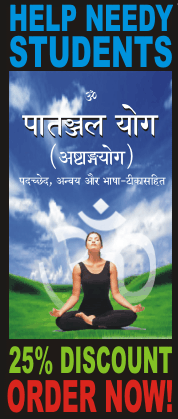

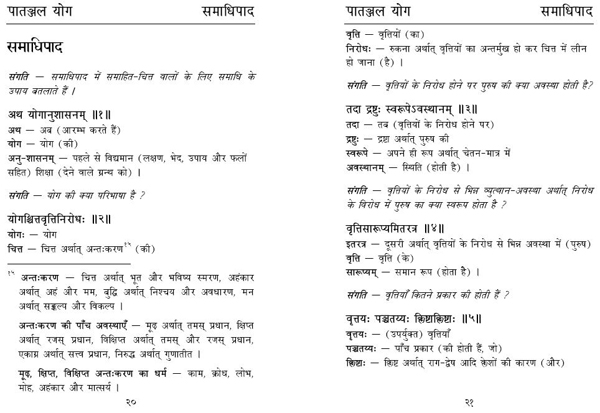
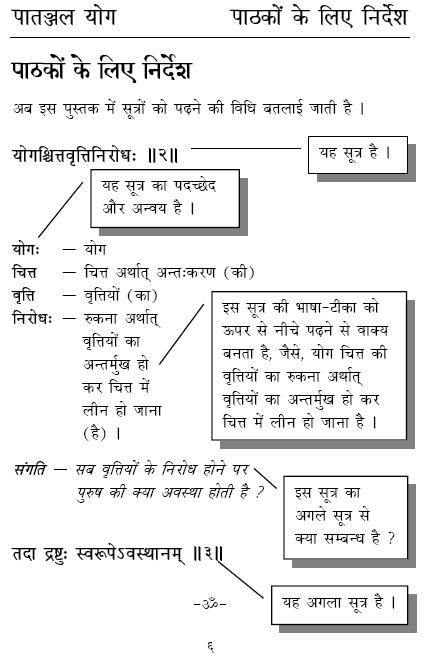
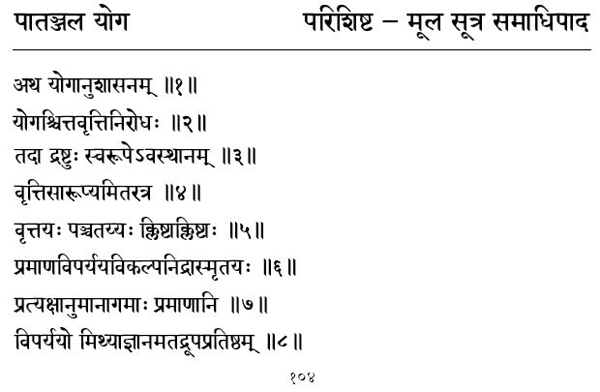
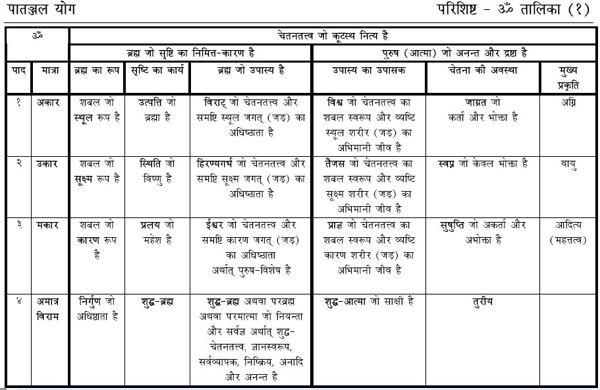
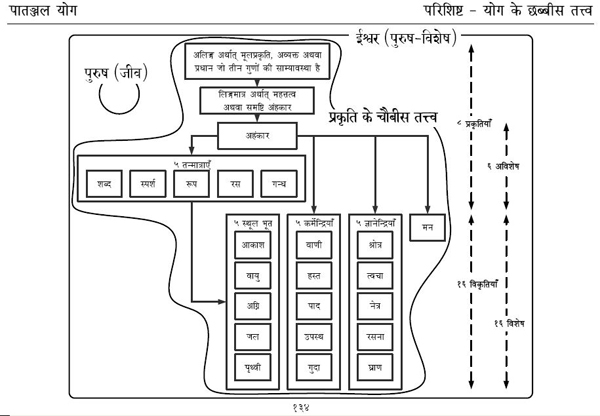
No comments:
Post a Comment